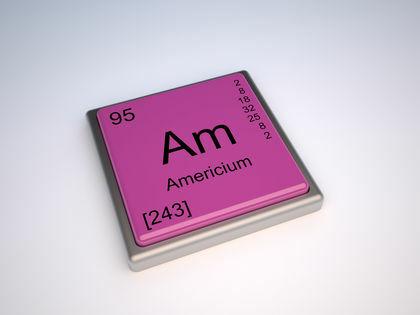O americium (name given in honor of the American Continent) is a chemical element radioactive and transuranic with am symbol It is atomic number 95 and atomic mass 243. It is an actinium element, found below the element europium in the periodic table, a lanthanide.
 It has the appearance of a white metal that is silverier than plutonium (Pu) and neptunium (Np), but slowly darkens in dry air. Its longest half-life isotope is Am-243 with 7.37 x 103 years. The metal is obtained by reacting AmF3 with steam. barium (Ba) at 1000-1200oC or by the reaction of AmO2 with lanthanum (There).
It has the appearance of a white metal that is silverier than plutonium (Pu) and neptunium (Np), but slowly darkens in dry air. Its longest half-life isotope is Am-243 with 7.37 x 103 years. The metal is obtained by reacting AmF3 with steam. barium (Ba) at 1000-1200oC or by the reaction of AmO2 with lanthanum (There).
see more
What is pH?
pH scale
It has a very short half-life and is not the decay product of any long-lived isotopes and is not found in nature. This element is created in nuclear reactors by multiple neutron capture by plutonium.
In the moment that americium-241 decays, gives off both alpha rays and gamma rays.
This element was discovered in 1944/45 by Seaborg, James, Morgan and Ghiorso, due to an irradiation of plutonium with neutrons.
While the first plutonium obtained on an industrial scale for the production of atomic bombs was being produced at the Hanford factory, researchers discovered elements 95 and 96.
The project lasted more than a year, and the difficulties were so great that one of the scientists in the group suggested that the two new elements be named “pandemonium” and “delirium”.
In fact, they named it “Americium” (by analogy with europium from the rare earth group) and “curium” in honor of the Curie couple.
When questioned by students during a radio program in November 1945, Seaborg announced the elements, revealing that the investigations developed around the atomic weapon had led to the isolation of two new elements.
So the young people convinced their teachers that this was true. However, the truth was only really declared with the official announcement to the scientific community.

Americium metal, when freshly obtained, has a shiny silver-white appearance (more silver than plutonium or neptunium), slowly losing its brightness due to the presence of dry air, at a temperature environment.
Its emission is, on average, three times greater than that of radio. In addition, the Am-241 has an intense emission of gamma rays.
Although this isotope is extremely expensive to produce in usable quantities, it has many applications. Americium is present in some smoke detectors containing minute amounts of Am-241 in the form of ionizing radiation source and americium dioxide.
Additionally, the Am-241 has been used as a portable source of gamma rays for use in radiography. It also serves to calibrate the thickness of glasses, making it possible to obtain very flat glasses.
Americium is also used in the production of neutrons for analytical probes due to the penetration power of radiation emitted by this element, since the gamma rays emitted by Americium are more penetrating than the X ray.
To give you an idea, penetrating americium rays have already been used in radiographs to check the amount of fat in tissues and minerals in bones.
The heaviest isotope, americium 243, is very useful in chemical studies and in the production of curium 244, which in turn is generated in kilogram quantities as an isotopic source of energy.
If you come into contact with this element, you must be careful, as it is highly radioactive due to the high emission of alpha radiation. and gamma, which in turn can cause damage to the nucleus of healthy cells in the human body due to their high energy and high penetration depth in the skin.
state of matter solid
Fusion point 1449K
Boiling point 2880K
enthalpy of fusion 14.39 kJ/mol
Steam pressure 1 Pa at 1239 K
electronegativity (Pauling) 1.3
specific heat 62.7 J/(kg·K)
Electric conductivity 1.5 x 106 S/m
thermal conductivity 10 W/(m·K)
1st ionization potential 578 kJ/mol
